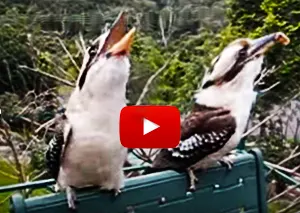Kookaburra Laughing Kookaburra
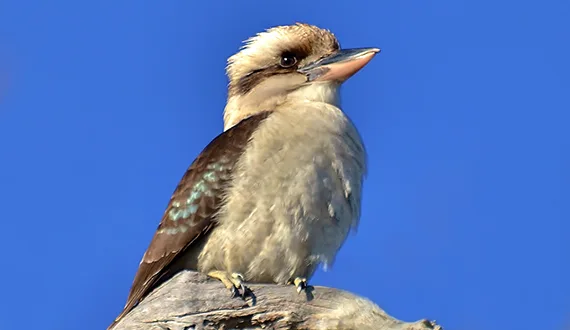
Photo: Kookaburra
The Kookaburra is a large terrestrial kingfisher with a loud and distinctive bird call that sounds like human laughter. It is 28-45 cm long, has a wingspan of 38 cm and weighs about 0.5 kg. The kookaburra has a large square head with a thick neck and a large beak that's almost as long as its head. The kookaburra's upper plumage is streaked in shades of dark brown, while its lower plumage is off-white in colour. The kookaburra has a reddish-brown tail with bands of black, and its large brown eyes give it excellent vision. There are no distinguishing differences between the male and female kookaburra, except that the male is slightly smaller than the female and also has more blue colouring on its wings and rump. To conserve energy, the kookaburra flies slowly and also lowers its metabolism and body temperature (by up to 9.1°C) during the night.
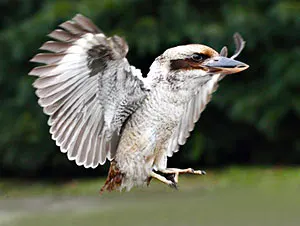
Photo: Kookaburra flying
The kookaburra has a loud and distinctive bird call that sounds like human laughter, earning it the nickname "Laughing Kookaburra and "Laughing Jackass". Because of the riotous noise they make, a group of kookaburras is called "a riot of kookaburras".
Kookaburras have a lifespan of 15-20 years and have one mate for life. Kookaburras live in loosely-knit family groups with clearly defined territories. The family unit consists of a monogamous male and female pair and up to 6 helper birds. These helper birds are older generations of offspring who help their parents to care for the next generation of siblings.
There are four species of kookaburras: the Laughing Kookaburra (Dacelo novaeguineae), the Blue-winged Kookaburra (Dacelo leachii), the Rufous-bellied Kookaburra (Dacelo gaudichaud), and the Spangled Kookaburra (Dacelo tyro).
Kookaburra Laugh Why Do Kookaburras Laugh
The kookaburra's distinctive call, often described as sounding like human laughter, is actually a warning. Starting with a slow 'oooo' chuckle, it then builds up to boisterous 'ha ha ha'. The kookaburra's call is a communal behaviour to stake out the family unit's territory and caution other birds to stay away. Members of a family unit vocalize together in a similar manner, as though they are all laughing from the same "hymn sheet", creating a chorus that reverberates through the forest and amplifies their claim to their territory. Rival groups may also respond, resulting in a cacophony that sounds like raucous laughter to human ears. For this reason, a group of kookaburras is called "a riot of kookaburras".
Kookaburra Diet What do Kookaburras Eat?
Kookaburra Loves to Eat Snakes
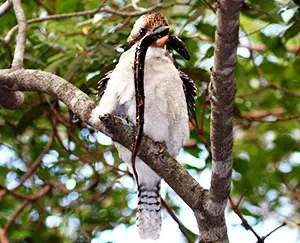
The way it eats snakes is neat. It swoops down and grabs the snake from behind its head and then flies up into the air and drops the snake to kill it. Sometimes it bashes the snake against a branch or rock to kill it and soften it up, or break it up into smaller pieces.
(This is an excerpt from the original TrishansOz page written in 1997 when Trishan was 9 years old.)
Kookaburras are carnivorous and eat lizards, frogs, snakes, small animals, insects, worms, fish, crabs, and even other birds. They are opportunistic hunters and will eat whatever prey is available to them in their habitat.
A kookaburra's hunting technique is a 'perch and pounce' strategy typical of kingfishers. It will perch on a branch and wait for its prey to pass by. Once It spots its target, it swoops and grabs it with its powerful beak. If the prey is small, the kookaburra will swallow it whole. However, if the prey is too large to eat whole, the kookaburra will bash it against a hard surface to break it into smaller, consumable chunks. This bashing behaviour has resulted in the kookaburra having extremely strong neck muscles compared to other birds. It may also drop its victim from a great height to kill it.
Kookaburra Habitat Where Do Kookaburras Live?
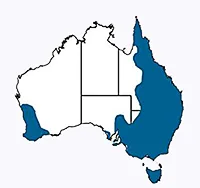
Photo: Kookaburra distribution map
Kookaburras live in eucalyptus forests and woodlands throughout eastern Australia. They have also adapted to living near humans and can often be spotted in urban parks and gardens. Humans also introduced kookaburras to Tasmania, Western Australia, and New Zealand.
The kookaburra is a sedentary territorial bird. That is to say, it marks its territory and lives there year after year. The territory of a family group can range between 16 to 244 hectares depending on the availability of prey in the particular habitat. They will honour the domain of another and will not enter it for any reason, even if it means catching a meal in their neighbour's territory.
Kookaburras roost with members of their own social group. Mating pairs nest in tree hollows or any large hole that can accommodate an adult bird. They may even nest in termite mounds in trees.
Kookaburra Reproduction & Life Cycle Baby Kookaburra
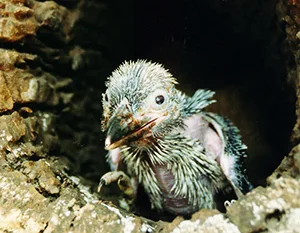
Photo: Kookaburra chick in tree hollow
Kookaburras reach sexual maturity and adulthood at one year of age. They pair for life, with the nesting season starting in September and ending in January. The female lays three eggs, usually a day or two apart, and incubates them at night while the male and older siblings also help to incubate the eggs. The incubation period lasts 24-26 days, and the young birds are born naked and blind. However, there is a high level of siblicide (killing a brother or sister) among hatchlings, with the third chick rarely surviving due to attacks from the other two. The entire family, including parents and older siblings, help care for and feed the chicks. Unlike other birds, young kookaburras often stay with their parents to help defend the family's territory and assist in raising future offspring.
Kookaburra Predators & Threats What Kills Kookaburras?
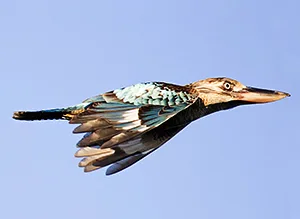
Photo: Kookaburra in flight
Kookaburras face a variety of threats, from predators and habitat loss. Older birds are particularly vulnerable to airborne predators like goshawks, owls, and eagles and introduced animals such as feral cats and foxes. In addition, possums prey on kookaburra eggs, while young chicks may fall victim to quolls, goannas, and snakes. However, the most serious threat to kookaburras is the destruction of their habitat, particularly eucalyptus forests and woodlands where they hunt and nest. Additionally, their slow-flying nature puts them at risk of being hit by motor vehicles. They may also become road-kill while scavenging for food. Finally, forest fires also devastate large areas of kookaburra habitat.
One Crazy Kookaburra
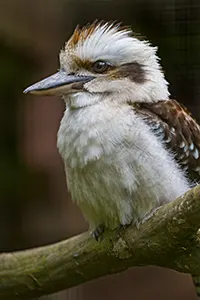
We have a crazy Kookaburra living in our garden. He thinks he is our alarm clock. He taps really hard and long on our lounge room window early each morning. He wakes us all up. When Dad decided to cover up the window with a plastic sheet, the kookaburra decided to dive-bomb another window. I am surprised he hasn't broken the window yet because he crashes so hard into it. Or even killed itself!
(This is an excerpt from the original TrishansOz page written in 1997 when Trishan was 9 years old.)
Kookaburra Conservation Status Are Kookaburras Endangered?
The kookaburra is not endangered. Despite the potential for decline due to human impacts like habitat destruction, the kookaburra population is estimated to be around 65 million birds. However, these iconic Australian birds are still protected by strict conservation and protection laws to ensure their continued survival and well-being.
Kookaburra Song by Marion Sinclair Controversial Australian Nursery Rhyme
The popular Australian nursery rhyme "Kookaburra Song" or "The kookaburra sits in the old gum tree" was written by Marion Sinclair in 1932. It was recently embroiled in controversy when the current copyright owner of the song claimed that the song Down Under by the famous Australian pop group, Men At Work, had plagiarised a part of the music from this song.
25 Kookaburra Facts
- The kookaburra is the world’s largest kingfisher.
- It is a stocky bird with a bird-call that sounds like human laughter.
- For this reason, its other names are Laughing Kookaburra and Laughing Jackass.
- A group of kookaburras is called a riot because they sound like a crowd of noisy humans.
- The word kookaburra came from the Australian Aborigine word guuguubarra and was derived from the sound the bird makes.
- It is pronounced cook-a-bar-ra.
- Kookaburras lives in eucalyptus forests throughout eastern Australia.
- The kookaburra flies slowly to conserve energy.
- It also lowers its metabolism and body temperature at night to save energy.
- Male and female kookaburra are similar in appearance. The female is a bit larger.
- Even though the kookaburra is a kingfisher bird, it doesn't fish much.
- However, it uses the same perch and pounce tactics used by kingfishers to catch its prey and fly back to its perch.
- Its diet consists of large insects, frogs, fish, crabs, and crayfish.
- It also eats small animals, other birds.
- It loves eating small snakes.
- It bashes large prey such as snakes and lizards against a branch to kill them.
- The kookaburra has very strong neck muscles, compared to other birds, because of this bashing behaviour.
- Kookaburras don't drink much water; they get all they need from their food.
- But they love to bathe in water.
- Kookaburras are monogamous. They pair for life.
- They can become quite tame around humans.
- Older Kookaburras are most vulnerable to airborne predators.
- Young chicks also fall prey to quolls, goannas and snakes.
- A kookaburra held alone in captivity will not laugh.
- A kookaburra lives for 15-20 years.
All Rights Reserved. (Last Updated: Oct 18, 2023)
